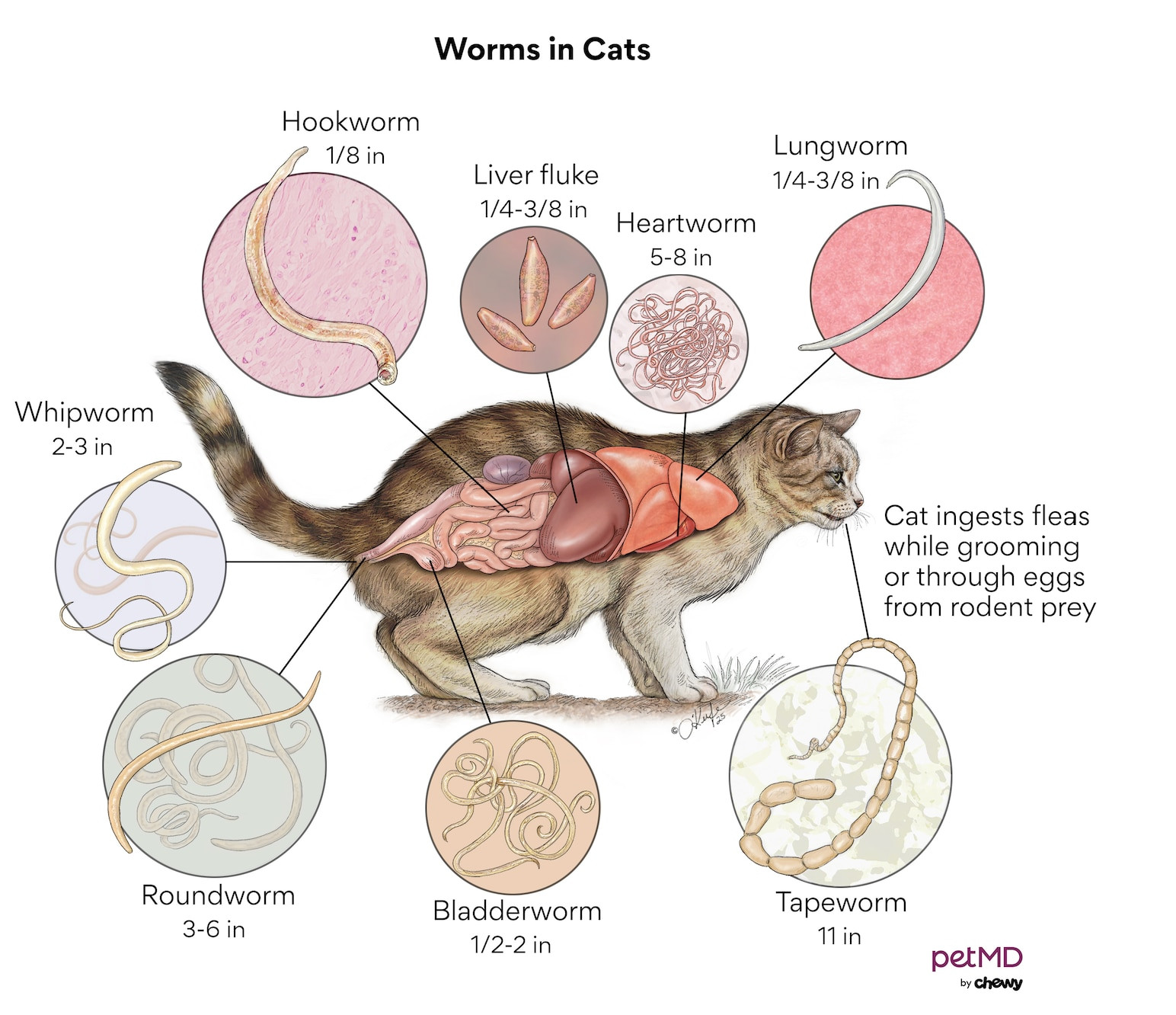Discovering worms in your cat’s stool can be unsettling for any pet owner. It’s important to know that intestinal worms are common parasites affecting both kittens and adult cats. In fact, studies indicate a significant prevalence of these parasites in domestic cats. While generally not an immediate emergency, a severe worm infestation can pose serious health risks to your feline friend.
 Diagram illustrating different locations of worms in cats
Diagram illustrating different locations of worms in cats
If you observe any signs of worms in your cat’s feces, promptly consult with your veterinarian. Providing a photograph or a stool sample can greatly assist in identifying the specific type of worm and determining the most effective treatment.
Seek immediate veterinary attention if you notice additional concerning symptoms such as pale gums, labored breathing, vomiting, or loss of appetite, as these could indicate a more serious condition related to worm infestation.
Common Types of Worms in Cats
Gastrointestinal worms are the most frequently encountered type of worms in cats. These include:
- Roundworms: These are among the most common intestinal parasites in cats, often resembling spaghetti.
- Hookworms: Smaller than roundworms, hookworms attach to the intestinal lining and feed on blood, potentially causing anemia.
- Tapeworms: Characterized by flat, segmented bodies, tapeworms are often contracted through fleas or by eating infected prey. Segments resembling grains of rice may be visible around the cat’s anus or in their stool.
- Whipworms: While less common in cats than in dogs, whipworms can still infect cats and reside in the cecum and colon.
Other types of worms that can affect cats, though less frequently, include:
- Lungworms: These worms reside in the lungs and respiratory system, causing coughing and breathing difficulties.
- Heartworms: Transmitted through mosquito bites, heartworms live in the heart and blood vessels, leading to severe heart and lung disease. Heartworm is more prevalent in dogs but can also affect cats.
Recognizing the Signs: Symptoms of Worms in Cats
The symptoms of worms in cats can vary depending on the type of worm and the severity of the infestation. Some cats may show no outward signs, especially in mild cases. However, common Signs Of Worms In Cats to watch out for include:
- Visible Worms in Stool or Vomit: This is often the most obvious sign. You might see whole worms or segments in your cat’s feces or vomit. Roundworms resemble spaghetti, while tapeworm segments look like rice grains.
- Diarrhea: Worm infestations can irritate the intestinal lining, leading to diarrhea, which may sometimes contain blood or mucus.
- Vomiting: Similar to diarrhea, vomiting can occur as the body tries to expel the parasites.
- Weight Loss: Worms steal nutrients from your cat, potentially causing weight loss despite a normal or even increased appetite.
- Increased Appetite: In some cases, the presence of worms can lead to an increased appetite as the cat tries to compensate for nutrient loss.
- Pot-bellied Appearance: Kittens with roundworm infestations may develop a distended abdomen or pot-bellied appearance.
- Coughing: Coughing, especially when accompanied by other respiratory symptoms, can be a sign of lungworms.
- Scooting: Tapeworms can cause anal irritation, leading to scooting or dragging their rear end along the floor.
- Lethargy and Weakness: Severe worm infestations, particularly hookworms, can cause anemia, leading to lethargy and weakness.
- Poor Coat Condition: A dull, dry coat can sometimes be an indirect sign of worms, as the parasites can affect overall health and nutrient absorption.
- Pale Gums: Hookworms feeding on blood can cause anemia, resulting in pale gums.
How Cats Get Worms: Causes and Transmission
Cats can contract worms in various ways:
- Mother to Kittens: Kittens are often infected with roundworms through their mother’s milk while nursing.
- Ingestion of Eggs or Larvae: Cats can ingest worm eggs or larvae from contaminated environments. This can happen when grooming after being outside, drinking contaminated water, or walking on contaminated soil.
- Eating Infected Prey: Hunting and eating rodents, birds, or other small animals that are infected with worms or their eggs is a common source of infection, particularly for tapeworms and roundworms.
- Flea Ingestion: Fleas can carry tapeworm larvae. When a cat grooms and ingests an infected flea, they can become infected with tapeworms.
- Skin Penetration: Hookworm larvae can penetrate the skin, particularly through the paws, leading to infection.
Keeping your cat indoors significantly reduces their exposure to many of these sources of worm infection.
Diagnosing Worms in Cats: What to Expect at the Vet
Diagnosing worms in cats typically involves a veterinary examination and a fecal test. Your veterinarian will:
- Physical Exam: Perform a general physical examination to assess your cat’s overall health and look for any visible signs of worms or related symptoms.
- Fecal Examination: A fecal sample is crucial for diagnosing intestinal worms. You can bring a fresh stool sample from home, or your vet can collect one during the appointment.
- Fecal Floatation Test: This common test involves mixing a small stool sample with a special solution that causes worm eggs and larvae to float to the surface, making them visible under a microscope. This test helps identify the type of worm infestation.
Even if you have observed worms in your cat’s stool, a fecal examination is still important to confirm the type of worm and to check for the presence of other types of worms, as cats can sometimes have multiple infections simultaneously.
Treating Worms in Cats: Deworming and Medication
Fortunately, most common intestinal worms in cats, including roundworms, hookworms, tapeworms, and whipworms, are treatable with deworming medications. These medications are available in various forms, including:
- Oral Medications: Pills or liquid medications given by mouth are commonly prescribed.
- Topical Medications: Some deworming medications are applied topically to the skin, often as spot-on treatments.
- Injectable Medications: In some cases, injectable dewormers may be used.
The specific medication and treatment duration will depend on the type of worm, the severity of the infection, and your cat’s overall health. Some worms may be eliminated with a single dose, while others require multiple doses administered over a period of time.
It is vital to strictly adhere to your veterinarian’s instructions regarding medication dosage and schedule. Follow-up veterinary visits and fecal tests are often necessary to ensure the treatment is effective and the worms have been eradicated.
The cost of deworming treatment varies based on factors such as the type of worm, the severity of infection, medication type and dosage, and the frequency of treatment.
Recovery and Aftercare
Cats with mild worm infestations typically recover fully within a few weeks of starting treatment.
To support your cat’s recovery, especially if they have experienced symptoms like vomiting or diarrhea, your veterinarian might recommend:
- Probiotics: Gastrointestinal probiotics, such as FortiFlora® or Proviable®, can help restore healthy gut bacteria, aid digestion, and support the immune system.
In cases of severe hookworm or roundworm infections, more intensive care may be needed, including:
- Deworming Medications: Prescription dewormers to eliminate the parasites.
- Hospitalization: For cats requiring supportive care.
- Fluid Therapy: To combat dehydration, especially if the cat has been vomiting or had diarrhea.
- Blood Transfusions: In severe cases of anemia caused by blood-feeding worms like hookworms.
- Emergency Surgery: In rare instances, a large mass of worms can cause intestinal blockage, requiring surgical removal.
Prevention is Key: Protecting Your Cat from Worms
Preventing worm infestations is always preferable to treating them. Key preventative measures include:
- Regular Deworming: Routine deworming, even for indoor cats, is recommended. Consult your veterinarian to establish an appropriate deworming schedule for your cat.
- Maintaining a Clean Litter Box: Regularly scooping the litter box and changing the litter helps reduce the risk of egg contamination. Disinfecting the litter box periodically is also beneficial.
- Routine Stool Testing: Regular fecal exams, typically twice a year for indoor cats and more frequently for kittens and outdoor cats, allow for early detection and treatment of worms.
- Year-Round Parasite Prevention: Using monthly parasite preventatives, such as Revolution® Plus, protects against not only worms but also fleas, heartworms, and other parasites.
- Indoor Lifestyle: Keeping your cat indoors minimizes their exposure to infected environments and prey animals.
- Regular Veterinary Wellness Exams: Annual or bi-annual wellness visits with your veterinarian are essential for overall health monitoring and parasite prevention.
Flea control is crucial for preventing tapeworm infections. Effective flea prevention measures break the tapeworm life cycle.
Consult your veterinarian about the best parasite prevention strategy for your cat, tailored to their individual needs and lifestyle.
Worms in Cats FAQs
Will worms in cats go away on their own?
No, worms in cats will not disappear without treatment. Untreated worm infestations can persist for months or even years, causing ongoing damage to your cat’s health. If you suspect your cat has worms, veterinary intervention is essential.
How do you deworm a cat at home?
Despite some purported home remedies like garlic or apple cider vinegar, there are no safe and effective at-home treatments for deworming cats. These methods are not scientifically proven to kill worms and may even be harmful to your cat. The safest and most effective way to deworm your cat is under the guidance of a veterinarian.
Are cat worms contagious to humans?
Yes, some types of cat worms, such as roundworms and hookworms, can be contagious to humans. Transmission typically occurs through accidental ingestion of worm eggs from contaminated soil, sand, or contact with infected cats. While these infections are relatively rare in humans, children and individuals with weakened immune systems are more susceptible. Practicing good hygiene, such as washing hands after handling cat litter or being in areas where cats defecate, is important.
How do you tell if your cat has worms?
While observing worms in stool is a clear indication, other signs like diarrhea, vomiting, weight loss, and a pot-bellied appearance can also suggest a worm infestation. However, the most reliable way to determine if your cat has worms is through a veterinary fecal examination.
By understanding the signs of worms in cats and taking preventative measures, you can help keep your feline companion healthy and worm-free. Always consult with your veterinarian for diagnosis and treatment of suspected worm infections.
WRITTEN BY: Molly Price, DVM
Veterinarian

